What is a binary search tree?
Binary-search-tree property:
Let \(x\) be a node in a binary search tree. If \(y\) is a node in the left subtree of \(x\), then \(y.key \le x.key\). If \(y\) is a node in the right subtree of \(x\), then \(y.key\geqslant x.key\).
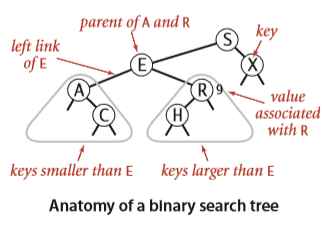
public class BST<Key extends Comparable<Key>, Value> {
private Node root;
private class Node {
private Key key;
private Value val;
private Node left, right;
private int N;
public Node(Key key, Value val, int N) {
this.key = key; this.val = val; this.N = N;
}
}
}Inorder tree walk: print all the keys in a BST in sorted order.
public void inorderTreeWalk(Node x) {
if (x != null) {
inorderTreeWalk(x.left);
System.out.print(x.val);
inorderTreeWalk(x.right);
}
}Theorem 1: If x is the root of an n-node subtree, then the call Inorder-Tree-Walk takes \(\Theta(n)\) time.
Assume: \(T(n)\le (c+d)n + c\)
\[ \begin{equation} \begin{aligned} T(n) &\le T(k)+T(n-k-1)+d\\ &=((c+d)k+c)+((c+d)(n-k-1)+c)+d\\ &=(c+d)n+c \end{aligned} \end{equation} \]
Searching
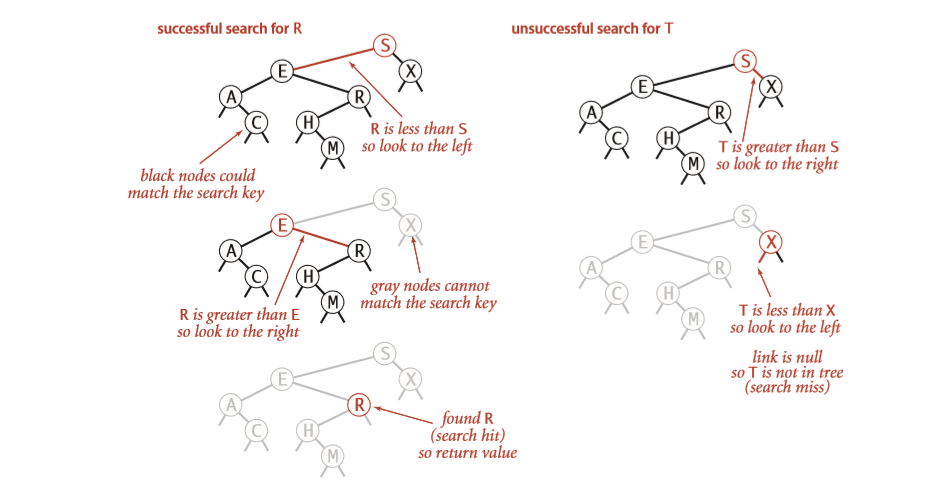
// recursive implementation
public Value get(Node x, Key key) {
if (x == null) return null;
int cmp = key.compareTo(x.key);
if (cmp < 0) return get(x.left, key);
else if (cmp > 0) return get(x.right, key);
else return x.val;
}// iterative implementation
public Value get(Node x, Key key) {
while (x != null) {
int cmp = key.compareTo(x.key);
if (cmp < 0) x = x.left;
else if (cmp > 0) x = x.right;
else break;
}
return x;
}Successor and Predecessor
Successor: the node with the smallest key greater than \(x.key\)
public Node treeSuccessor(Node x) {
if (x.right != null)
return min(x.right);
Node y = x.p;
while (y != null && x == y.right){
x = y;
y = y.p;
}
return y;
}Insertion

public void put(Node x, Key key, Value val) {
if (x == null) return new Node(key, val, 1);
int cmp = key.compareTo(x.key);
if (cmp < 0) x.left = put(x.left, key, val);
else if (cmp > 0) x.right = put(x.right, key, val);
else x.val = val;
x.N = size(x.left) + size(x.right) + 1;
return x;
}Deletion

public Node delete(Node x, Key key) {
if (x == null) return null;
int cmp = key.compareTo(x.key);
if (cmp < 0) x.left = delete(x.left, key);
else if (cmp > 0) x.right = delete(x.right, key);
else {
if (x.right == null) return x.left;
if (x.left == null) return x.right;
Node t = x;
x = min(t.right);
x.right = deleteMin(t.right);
x.left = t.left;
}
x.N = size(x.left) + size(x.right) + 1;
return x;
}Theorem 2: The running time of INSERT and DELETE is \(O(h)\).
Balanced BST
2-3 Search Trees
Property
- 2-node has one key and two links, \(x.left < x\), \(x.right > x\)
- 3-node has two keys and three links, \((A,B).left < A\), \(A<(A,B).mid<B\),\(B<(A,B).right\)
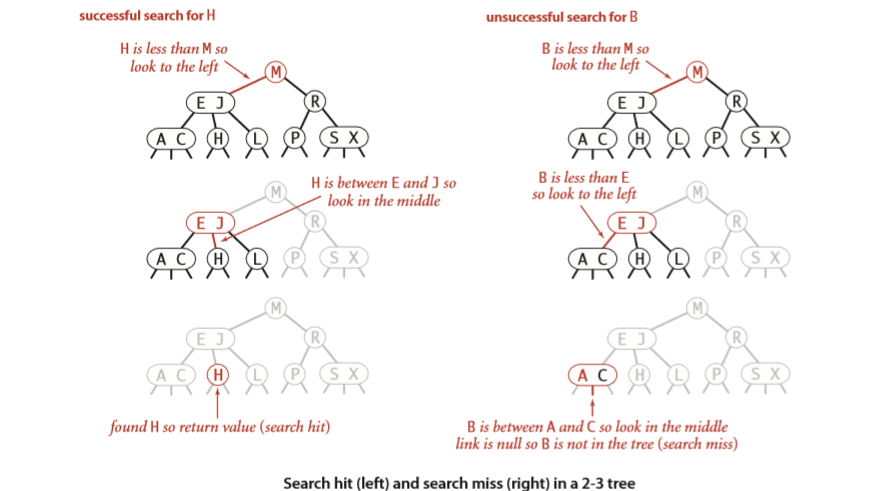
Insertion
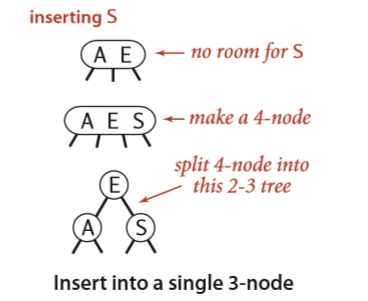
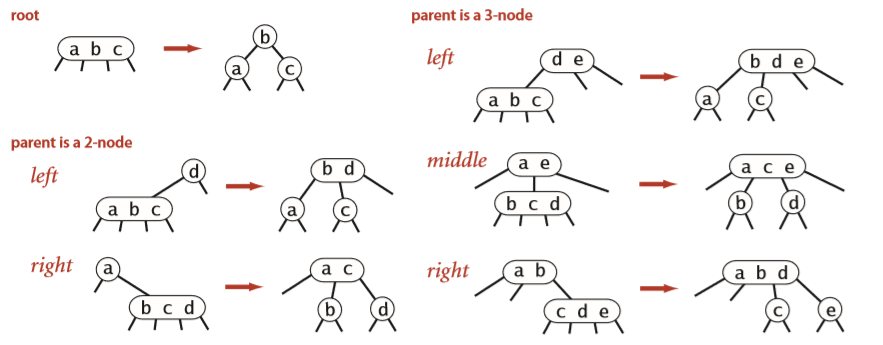
Red-Black Tree


Properties
- Every node is either red or black
- The root is black
- Every leaf is black
- If a node is red, then both its children are black
- For each node, all simple paths from the node to descendant leaves contain the same number of black nodes
Lemma 1: A red-black tree with n internal nodes has height at most \(2\lg{(n+1)}\)
Proof:
The black-height of the root must be at least \(h/2\); thus, \[ n \geqslant 2^{h/2}-1 \]
\[ \therefore h\le2\lg{(n+1)} \]
Rotation

public Node rotateLeft(Node x) {
Node y = x.right;
x.right = y.left;
y.left = x;
y.color = x.color;
x.color = RED;
y.N = x.N;
x.N = 1 + size(h.left) + size(h.right);
return y;
}Insertion
Three Case Insertion
Insert a node \(z\) into the tree. There are three cases in inserting the node into the tree.
case 1: z's uncle y is red
\(y=z.p.p.right\)
Then \(z.p\) and \(y\) become black, and \(z.p.p\) becomes red.

case 2: z's uncle y is black and z is a right child
Left rotate \(z\).
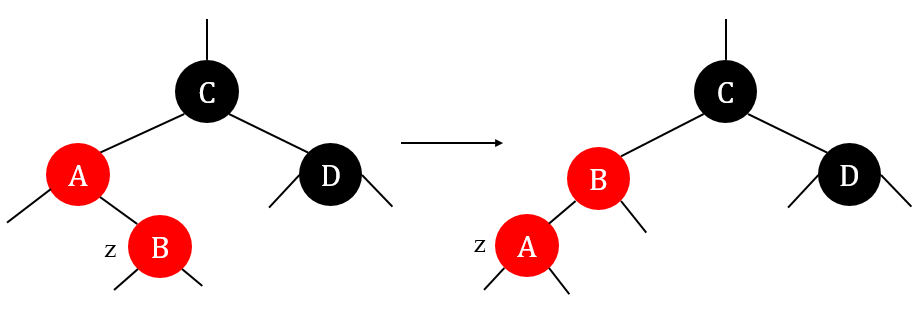
case 3: z's uncle y is black and z is a left child
Right rotate \(z.p.p\) and change color.

def RB_Insert_Fixup(T,z):
while z.p.color == RED:
if z.p == z.p.p.left:
y = z.p.p.right
# case 1
if y.color == RED:
z.p.color = BLACK
y.color = BLACK
z.p.p.color = RED
z = z.p.p
# case 2
else if z == z.p.right:
z = z.p
Left_Rotate(T,z)
# case 3
z.p.color = BLACK
z.p.p.color = RED
Right_Rotate(T, z.p.p)
else:
# exchange "left" and "right"
T.root.color = BLACKDeletion

(Screenshot from the textbook)
def RB_Delete_Fixup(T, x):
while x != T.root and x.color == BLACK:
if x == x.p.left:
w = x.p.right
# case 1
if w.color == RED:
w.color = BLACK
x.p.color = RED
Left_Rotate(T, x.p)
w = x.p.right
# case 2
if w.left.color == BLACK and w.right.color == BLACK:
w.color = RED
x = x.p
else if w.right.color == BLACK:
w.left.color = BLACK
w.color = RED
Right_Rotate(T, w)
w = x.p.right
w.color = x.p.color
x.p.color = BLACK
w.right.color = BLACK
Left_Rotate(T, x.p)
x = T.root
else:
# exchange "left" and "right"
x.color = BLACKReference
[1] Algorithms, 4th edition.